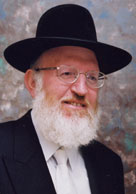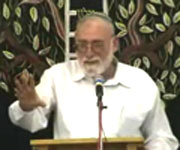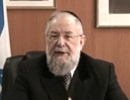Beit Midrash
- Jewish Laws and Thoughts
- Jewish Laws and Customs
- Various Subjects
The Torah study is dedicatedin the memory of
Asher Ben Haim
2. Calculating Morning Times
3. The Time for Reciting the Shema
4. The Time for Prayer
5. "Vatikin" Prayer at Sunrise
6. The Exact Times of "Vatikin" and "Hanetz HaChamah"
Morning Times
From the perspective of Jewish law, the first significant hour of the day is known as "Amud HaShachar" (Dawn), or, alternately, "Alote HaShachar." When circumstances do not allow otherwise, it is permissible to recite the Shema and to pray Amidah from this hour. Under normal circumstances, however, this is prohibited. Later authorities express differing opinions as to when exactly "Amud HaShachar" is: Some maintain that it is the time when the first faint light becomes discernible in the eastern sky (Magen Avraham, Pri Megadim), while others hold that it is slightly later, after the light has begun to spread across the eastern sky (Eliya Rabba; Vilna Gaon).
Following "Amud HaShachar" comes the "Mi-Sheyakir" hour. This is the time when the morning light has begun to make itself felt to the the point where one is able to recognize a rare acquaintance from a distance of four cubits. It is also possible at this time to distinguish between blue and white. At this hour, according to most authorities, it is entirely permissible to recite the Shema. Amidah, however, is still not permissible under ordinary circumstances.
"Hanetz HaChamah" means "sunrise." In other words, it is the time when the first part of the sun rises above the horizon. From then onward prayer is permissible. One who recites the Shema just before sunrise and then prays Amida with the sunrise is said to have prayed "Vatikin"; the sages praised this practiced in no uncertain terms.
All Torah commandments which must be fulfilled during the daytime may be fulfilled from the moment of "Hanetz," because the day is defined by the appearance of the sun. If, however, one acted from the hour of "Amud HaShachar," he is considered to have fulfilled his obligation. This is because, in a sense, when light appears, the day has begun.
Calculating Morning Times
According to many opinions, the amount of time that passes from"Amud HaShachar" to "Hanetz HaChamah" in Israel is equivalent to the amount of time it takes to walk four "Talmudic Miles," approximately seventy-two minutes. This means that in the months of Nisan and Tishrei, seventy-two minutes pass between dawn and sunrise. It is important to realize that this interval changes during the course of the year. In Nisan and Tishrei (March 5; October 5) seventy-two minutes pass from dawn to sunrise. During the winter months this interval reaches a heightened length of seventy-eight minutes; during the summer, a peak of eighty-eight minutes. In order to calculate the exact time of "Amud HaShachar" according to this method, one must on any given day calculate the moment at which the sun reaches a point 16.1 degrees below the horizon.
The above relates to the opinion that "Amud HaShachar" begins from the time that the entire eastern sky has become slightly illuminated. According to the opinion that "Amud HaShachar" begins when the first faint light becomes discernible in the eastern sky, its time is a bit earlier, viz., when the sun reaches a point of approximately 17.5 degrees below the horizon. In order to distance oneself from all discrepancy it is best to follow the former opinion (16.1 degrees under the horizon): When circumstances do not permit otherwise, one should at least wait until the light has begun to spread across the eastern sky before reading the Shema and praying Amida.
There is also a dispute regarding when exactly the time of "Mi-Sheyakir" begins. Even though the sages determined that it begins when it is possible to discern between blue and white and recognize a partial acquaintance at a distance of four cubits, there is still disagreement about when exactly this is. In practice, it begins at about 50 minutes before the sunrise.
The Time for Reciting the Shema
We learn when to recite the morning Shema from the Torah's expression, "When you rise" - i.e., at the hour when people are accustomed to rise from their sleep. And because some people rise early, at dawn ("Amud HaShachar"; 72 minutes before sunrise), this, according to the Torah, is the time of rising and it is then possible to read the Shema. The rationale for this is the fact that the Torah says "When you rise," in the singular, and this indicates that the Shema may be recited even at that hour when only a few individuals rise from sleep. A person who recites the Shema before this, however, has not fulfilled his obligation, for he has read before the time of rising.
The sages went a step further and created a fence around this commandment, establishing that, ideally, one is not supposed to recite the Shema until later, when more people are accustomed to rise: when there is enough light outside for a person to recognize an acquaintance from a distance of four cubits (Shulchan Arukh 58:1). This is the "Mi-Sheyakir" hour (about 50 minutes before the sunrise in the spring month of Nisan). When circumstance do not permit a person to wait until the "Mi-Sheyakir" hour to recite the Shema, it may be recited from the time of "Amud Hashachar." Similarly, after the fact, if one mistakenly read the Shema at this hour, he is seen as having fulfilled his obligation. Yet, a distinction must be drawn between a situation in which circumstances do not permit and a case where a person makes a mistake: If the reason for reading early is extenuating circumstances, one fulfills his obligation even if he must do this day after day; but where a person mistakenly read at such a hour, one fulfills his obligation only if this happens on rare occasions, viz., no more than once a month. The sages declared that such a person must, as a kind of penalty, recite the Shema again, after the "Mi-Sheyakir" hour (Shulchan Arukh 58:3-4, MB 54:19).
The time period for reading the Shema lasts three hours; for, because there are people - princes for example - who are accustomed to rising even as late as the end of the day's first quarter, the time for "when you rise" lasts for three of the day's twelve hours. The most desirable time for reading the Shema is just before the sun's rise ("Vatikin").
The Time for Prayer
The Men of the Great Assembly instituted praying three times a day, and they established the times for these prayers so that they correspond to the daily Tamid offerings in the Temple. Since the morning Tamid sacrifice was offered from dawn ("Amud HaShachar"), one might expect that the time for prayer would also begin at the dawn. The sages, however, said that it is best to pray after sunrise, in accordance with the verse, "May they fear you with the [rising of the] sun" (Berakhot 9b; Psalms 72:5). Yet, if one were to pray from dawn onward he nonetheless fulfills his obligation, for he has prayed at an hour acceptable for the offering of the morning Tamid (Shulchan Arukh 89:1). The choicest time for prayer is with the sun's rise ("Vatikin").
The time for prayer lasts for the first four hours of the day, for, according to R' Yehudah, the morning sacrifice may be offered up until the end of the first four hours of the day. And though the sages disagreed with R' Yehudah and held that the time for the morning Tamid continues until midday, the law follows the opinion of R' Yehudah. The reason for this is that R' Yehuda's opinion is that which appears in tractate Eduyyot, and we have a rule that all the Mishnayot in tractate Eduyyot were accepted as law. Therefore, the time designated for prayer lasts four hours, that is, the first third of the day (Berakhot 27a). All the same, the opinion of the sages was not completely dismissed; if four hours passed and one has still not prayed, one may after the fact pray until noon. And though such a person is not credited with praying at the proper time, he is still rewarded for praying.
"Vatikin" Prayer at Sunrise
The best possible time for reciting the Shema and praying Amida is at the "Vatikin" time. The "Vatikin" were people who would read the Shema just before sunrise and then pray at sunrise. The reason for this practice is that one who prays late allows himself to be controlled by nature: After the sun has begun to shine and life is in full swing, he wakes up and recognizes God's sovereignty, accepts the yoke of the Kingdom of Heaven upon himself, and prays. The "Vatikin," however, get up early and take nature by the reins. Before the sun begins to shine, causing nature's beauty to be revealed, the "Vatikin," with complete faith, accept the yoke of the Kingdom of Heaven upon themselves, and, as soon as the sun shines and the day begins they begin to pray, causing abundant blessing to descend upon the world.
The sages say that following the example of the "Vatikin" protects a person from danger for the entire day (Berakhot 9b, Tosefot ad loc.). However, if a person knows that praying like the "Vatikin" will cause him to become tired and he will not be able to study or work as he should, it is better that he pray later. In addition, today, man's daily routine has changed and many important activities (Torah classes and weddings, for example) take place at night. Most people are therefore better off sleeping a bit later in the morning and praying after "Vatikin" time.
The Exact Times of "Vatikin" and "Hanetz HaChamah"
"Hanetz HaChamah" (lit. "the sparkling of the sun") is the term used to describe the time when the sun begins to shine in the morning. And while, on the face of things, this appears to be a fairly clear-cut and simple definition, the truth is that it is not so simple.
To begin with, the amount of time it takes for the sun to rise - from the moment that one sees its first splinter, until it is completely visible - is approximately two-and-a-half minutes. Authorities are at ends regarding what exactly is the time of "Hanetz": The majority opinion is that it occurs when the very first splinter of sun becomes visible, and this is the time, in their opinion, at which the Amidah prayer of "Vatikin" must begin. Others, however, hold that "Hanetz" is when the entire sun has finished rising and can be seen in its entirety on the horizon. Still others contend that "Hanetz" lasts lasts for two and a half minutes, so long as the sun's rays are still red. In practice, while people do their best to begin their prayer with the beginning of the rise of the sun, they are not overly careful about this because they take into account the other opinions.
Another issue which has drawn attention is the question of landscape: Should mountains which block out the sun be taken into account, or do we go according to the "astronomical sunrise," viewing the horizon as if it were one big plane? It goes without saying that a person who is standing next to a cliff or a towering building cannot claim that sunrise for him is the time when he himself sees the sun, for his sunrise might end up being close to noon! The question arises, rather, in a case like Jerusalem's Old City, where the Mount of Olives blocks the eastern horizon. There, the sun appears a number of minutes later than it would if the Mount of Olives did not block out the sun. And even if one stands on the Mount of Olives, the Moab Mountains in Jordan block out the beginning of the sun's appearance.
Some opinions say that "Hanetz" is when you actually see the sun, i.e., when the sun appears on top of the Mount of Olives; others hold that near-by mountains like the Mount of Olives are not to be taken into account because they can be reached by foot. Distant mountains like the Moab Mountains, on the other hand, must be taken into consideration. In practice, the difference between these two opinions amounts to a few minutes.
Still others say that we do not take the natural horizon into consideration at all; rather, sunrise calculations must be made as if the horizon was flat, i.e., according to the time the sun would appear if there were no mountains whatsoever. Today there are computer programs which allow one calculate the astronomical sunrise at whatever location one desires, and many are accustomed to determining the sunrise accordingly.

The Torah’s Instructions to Non-Jews—The Laws of Bnei Noach
Rabbi Yirmiyohu Kaganoff | Ceshvan 1 5780

A Fishy Tale
Rabbi Yirmiyohu Kaganoff | 5768
A Woman's Obligation to Pray
Rabbi Eliezer Melamed | 5766























